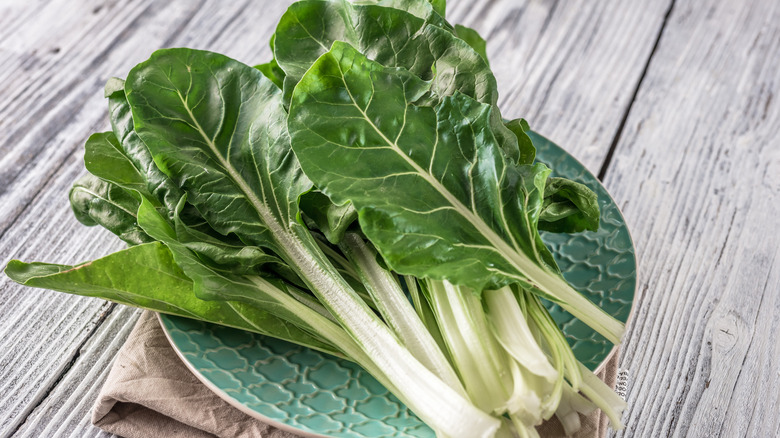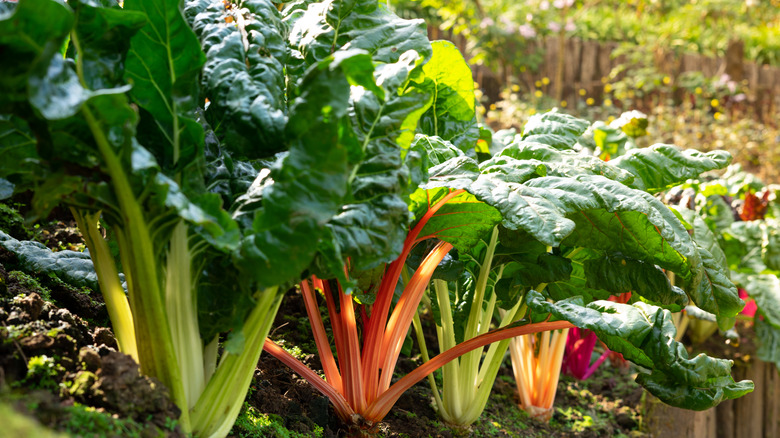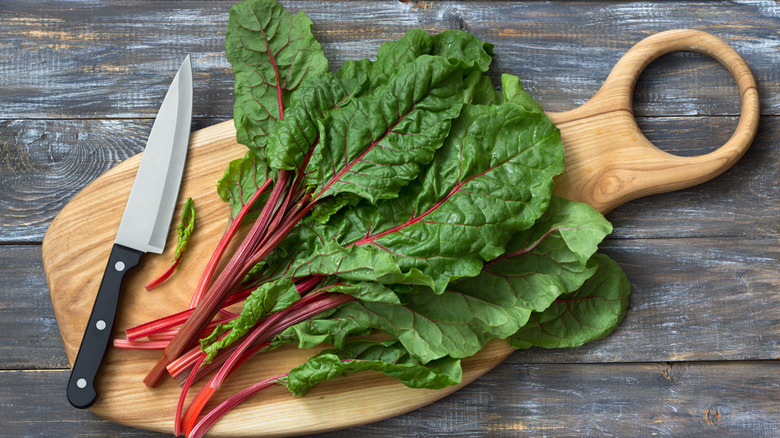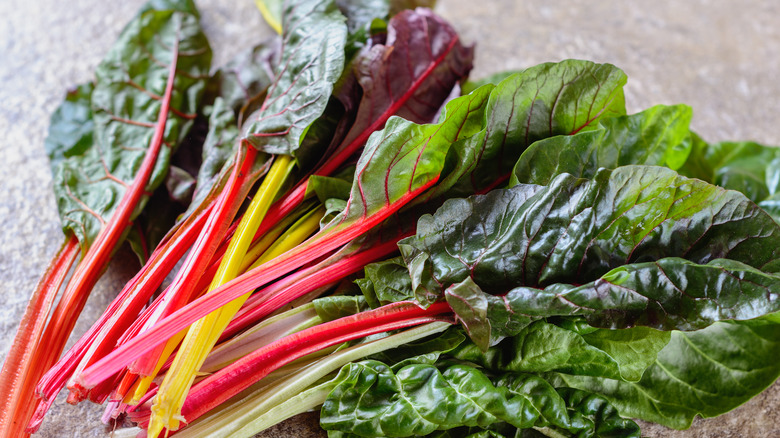What Is Chard And What Does It Taste Like?
Chard, or Swiss chard as it is often called, is a descendent of the Chenopodiaceae family and is closely related to the beet, according to the New England Vegetable Management Guide. While beets are grown for their roots and leaves, chard is cultivated for its leafy greens and crunchy stems. But according to Harvesting History, chard has years on beets.
Seriously, The Rambling Epicure points out that even that old philosopher Aristotle — you know, the one who was always getting into it with Plato — wrote about this cruciferous vegetable way back in the fourth century. In fact, the blogger shares that chard has often been a victim of mistaken identity. Its name probably came from the French who often confused it with the cardoon, another plant that has a celery-like stalk. This leads us to why it is called Swiss chard. Per Colorado Integrated Food Safety Center of Excellence, Swiss was not added to be pretentious or make it sounds more European, but rather Swiss was added to chard's name to differentiate it from French chard.
Varieties of chard
So, how many varieties of chard exist today? Per MasterClass, Swiss chard has white stalks and big green leaves, but there are several other types. Colorado Integrated Food Safety Center of Excellence shared a list which includes Bright Lights, Bright Yellow, Fordhook Giant, Lucullus, Rhubarb Chard, Rhubarb Red, and Ruby. Collectively, their colorful stalks are commonly referred to as rainbow chard, a nod to their red, yellow, orange, or purple stems.
Furthermore, it is suggested that chard is quite hardy and will grow well pretty much anywhere in any soil. Harvesting History also notes that it can thrive through a hot summer or a mild, but frosty cold winter. This may explain why those early colonists were so fond of it in the United States. The Rambling Epicure mentioned how the Romans used chard for its medicinal purposes, but Harvesting History shares that by the time the colonists brought it to the shores of America, its use had evolved. They were boiling up this leafy vegetable like spinach in soups. Still, according to Colorado Integrated Food Safety Center of Excellence, it really gained in popularity in the late 19th century when farmers really started growing it with purpose.
What does chard taste like?
Which brings us to the next, and perhaps the most important question: What does chard taste like? MasterClass describes this nutrient-packed vegetable as bitter when eaten raw, but cook it up, and the taste changes to mild and sweet, similar to spinach. Colorado Integrated Food Safety Center of Excellence also noted that today, it is actually considered the perfect substitute for spinach.
MasterClass notes that you generally chop off the leaves from the stalk before you cook them, but they also urge you not to toss the stalks. Instead, use them to snack on like you would celery, cook them up with other vegetables, or even pickle them. They also give fair warning that because of their thickness, they need a little more time to cook than the leaves, so prep and plan accordingly.
How do you prepare chard?
Cooking with chard is really easy so don't be intimidated. Young chard tastes great in salads while big leafy chard is fabulous on pizzas or mixed with your favorite protein. Food Network even recommends using it in a quiche. And when it comes time to prepare chard, the site shares that an easy rule of thumb to follow is to use the leaves like you would spinach and the stalks like you would asparagus. In fact, they say if you just sauté your chard and mix it with some lemon, butter, or garlic, you've got yourself a nice side dish.
So how do you chop it up? Cutco.com instructs new chard preppers to cut the stalks crosswise after you cut the leaves from the stalks. Once you are done with the stalks, turn your attention to the leaves. Stack them up and simply cut them into long strips or ribbons. It's really that simple.
Chard's nutrition and how to store
Chard is also good for you. MasterClass touts all of its nutrients, listing vitamin A, vitamin C, vitamin K, and a plethora of antioxidants as a part of chard's resume. Healthline even lists it as one of the healthiest leafy green vegetables, adding potassium and manganese to its laundry list of nutritional content. In some studies, chard may be useful when it comes to controlling blood sugar levels. That's a lot of reason to add this member of the beet family to your diet.
What about storing your chard? The shelf life of chard is relatively long. Colorado Integrated Food Safety Center of Excellence says you can store your chard in the refrigerator for up to a week, possibly two. Bon Appétit recommends wrapping it in a damp paper towel and storing it in an open plastic bag in the crisper drawer. You can also freeze your chard for later use, but if you do, GardeningChannel.com recommends blanching them first to ensure they will still taste good when you use them at a future date.




